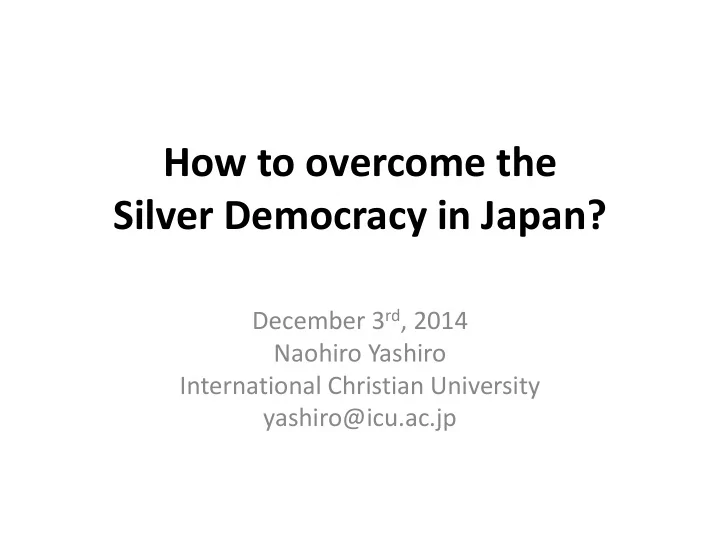

How to overcome the Silver Democracy in Japan? December 3 rd , 2014 Naohiro Yashiro International Christian University yashiro@icu.ac.jp
Japan’s population will decline from 127 million in 2010 to 87 million in 2060 Population estimates 2012.1 130000 125000 120000 115000 110000 1000 105000 100000 95000 90000 85000 80000 1960 1965 1970 1975 1980 1985 1990 1995 2000 2005 2010 2015 2020 2025 2030 2035 2040 2045 2050 2055 2060 Source: Population and Social Security Institute 2002 2006 2012 2
Rapid aging of the elderly 45 40 35 30 25 Million 20 15 10 5 0 1950 60 70 80 90 2000 10 20 30 40 50 60 Source: Population and social security institute Ratio of age 65 and above( %) 65-74 75+
Significant inequality in net social security benefits between generations 4
Japan’s social security entirely depends on deficit financing 120 Social security expenditures and contributions (Trillion yen) 100 80 60 40 20 0 2010 2013 1975 1980 1985 1990 1995 2000 2005 Source: Population and Social Security Research Institute Social security expenditures Social security contributions National bond issues SS balance 5
Silver democracy: voting ratios are constantly higher for older age groups 80 70 20-29 60 30-39 40-49 50-59 50 60-69 70 and over 40 30 20 1989 1992 1995 1998 2001 2004 2007 2010 2013
Pensions and medical care for the elderly account for a large share of social security
Political intervention prevented reducing pension benefits due to deflation The statutory and actual level of pension • The Pension Law benefits (1999=100) 100 requires automatic 99.5 adjustments of the 99 98.5 benefits according to 98 price changes. But, 97.5 97 politicians passed 96.5 96 the special law to 95.5 freeze it in case of 95 2000 2005 2010 2013 Source: Ministry of Health, Lbor and Welfare deflation. Actual level Statutory level
Proposals for revising the election scheme to reduce the elderly’s voice • Voting rights should be appropriated to parents by the number of their children. • A Diet member should be proportioned in “young bracket ( 20-30 year ) ” “middle-aged bracket ( 40-50 year ) ”, and “elderly bracket ( over 60s years ) ”.
Who is to bell the cat? • Any trials to reduce the political power of the elderly are likely to be rejected under the silver democracy.
① Threatening the elderly • The social security fund has been shrinking, and is likely to be exhausted by 2030. • If the credibility of national bond declines, 40% of the benefits may well be cut. • Current social security is “high risk, high return assets” for the elderly. • By cutting the benefits by 20% now, it becomes “low risk, low return assets”.
Credibility of government bonds will decline with accumulating debts 250 Public debt to GDP ratios (%) 200 150 Japan USA 100 EURO 50 0 1993 1994 1995 1996 1997 1998 1999 2000 2001 2002 2003 2004 2005 2006 2007 2008 2009 2010 2011 2012 2013 Source OECD Economic Outlook 12
② Appealing to altruism of the elderly • The Japanese elderly do care for their grand- children and spend on average $2400 in a year for them. • If the elderly were well informed the current situation on significant income transfers from the grand children’s generation, they may well accept cuts in social security benefits.
Small differences in views on social security burden sharing by age groups 35 Opinion poll on the social security burden sharing, 2012 30 25 20 15 10 5 0 20-24 25-29 30-34 35-39 40-44 45-49 50-54 55-59 60-64 65+ Source: Ministry of labor,Health and Welfare Increasing burden on the working generation Increasing burden on the elderly generation
Economic revitalization policies to address the demographic challenge • Higher labor force participation of women and 30% target for female managers; • Lower corporate tax rate; • Improving labor market mobility. Growth a h acco ccount unting ng o of J Japan ( n (%) %) GDP Con ontribution on of of growth th r rate te Labo bor Capital TFP FP 1980-1990 1980-1990 4. 4.64 64 0.6 .6 2. 2.19 19 1. 1.84 84 1991-2000 1991-2000 1. 1.13 13 -0. -0.48 48 1.2 .2 0.4 .4 2001-2010 2001-2010 0. 0.76 76 -0. -0.49 49 0. 0.48 48 0. 0.77 77 Sour urce: ce: M Mizuho uho R Res esea earch I ch Ins nstitut ute
Reviewing the role of the Government • Basic social security and health care provision is the governments responsibility; • They could be combined with value added private services in the markets; • Regulatory reform of health and nursing care provision would create production and employment as well as tax revenues.
Summing up • Aging of the population is gloomy for the public sector with growing expenditures; • An increase in the elderly population implies growing markets for the private sector; • Expanding “Silver Markets” through regulatory reform is the key to Japan’s economic revitalization.
Recommend
More recommend